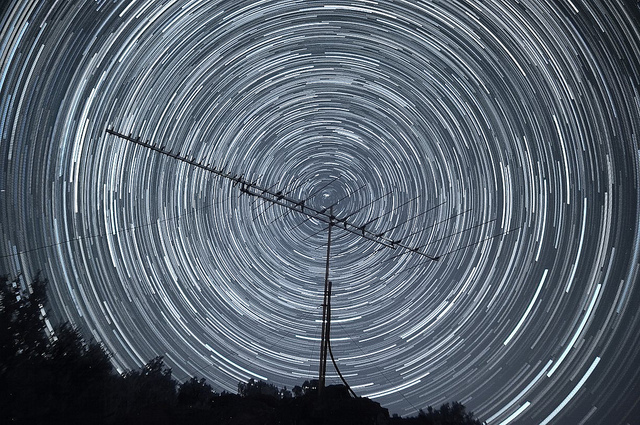Problems with photographing star trails?

So today I decided to try and shoot a star trail. I have a nikon d3200 with an 18-55 kit lens and I used an shutter release timer remote. I did 60 1 minute exposure with one second in between exposures. I think that is where I went wrong, with the interval timing. I stacked all my images together using StarStax, and the trails came out as dotted lines versus solid lines. Is there a way to fix this?
here's another example very similar to what happened to my photo ( I don't own this photo)
http://www.dpreview.com/...73&image=0
and this is the type of star trail I want:

- see how this one right above has fluid, solid trails versus the first one? That's what I'm confused about

Can you verify that the camera was set to 60 seconds, and therefore the shutter closed and then opened immediately?
I ask because my old brick of an Olympus often needs to process a long image for some time before I can take another. The images in that photo look evenly spaced, so if that's the case, maybe the photos were being taken at one-minute intervals.
I take trail photos on film, so I'm not sure if that makes sense, but see if if that might be happening.
I've just accessed the description on that site. That process is what I mean; the camera processes the image, especially if it's on "noise reduction" setting.
The problem is that you need a more powerful flash unit.
Well, unless you deselect the long exposure noise reduction (which is turned on by default), for every long exposure the camera will run a cycle of equal time to try to map out and subtract hot pixel noise.
If you want star trail photos, I suggest that you get one of these
http://www.idahocamera.com/Promaster-2500PK-Super-Camera-50mm/dp/B000PKP4L0?field_availability=-1&field_browse=8905428011&field_keywords=2500+pk+super&id=Promaster+2500PK+Super+Camera+50mm&ie=UTF8&refinementHistory=brandtextbin%2Csubjectbin%2Ccolor_map%2Cprice%2Csize_name&searchKeywords=2500+pk+super&searchNodeID=8905428011&searchPage=1&searchRank=salesrank&searchSize=12
and one of these
http://www.idahocamera.com/Kalt-Cloth-Standard-Cable-Release/dp/B00009R7ZL?field_availability=-1&field_browse=8905428011&field_keywords=cable+release&id=Kalt+Cloth+Standard+Cable+Release&ie=UTF8&refinementHistory=brandtextbin%2Csubjectbin%2Ccolor_map%2Cprice%2Csize_name&searchKeywords=cable+release&searchNodeID=8905428011&searchPage=1&searchRank=salesrank&searchSize=12
Just use a bit of common sense - you took a 60 second exposure and then waited a second and took another 60 second exposure and you wonder why there's a break in the line of light when you stack the two? You broke the exposure, so you broke the line.
If you were to take the image with the continuous star trails that you like and carefully locate the center and then draw lines from the center to the two ends of a selection of the curved tracks, you would find the angle between the lines is exactly the same for all of the streaks. And that angle would tell you exactly how long the shutter was open. I downloaded an onscreen protractor and found they were about 21 degrees (I didn't want to pay for the program, so demo is a bit awkward)
Although I may be wrong in calcs to me that means the shutter was open for 21 / 360 * 24 * 60 = 84 minutes (21 of 360 degree daily circle, 24 hours of 60 minute.
You might want to try this program for doing star trails -
http://startrails.de/html/software.html
Also, take your time. And insure that each step of the process is working the way it should. Such as doing a dry run during the day.
